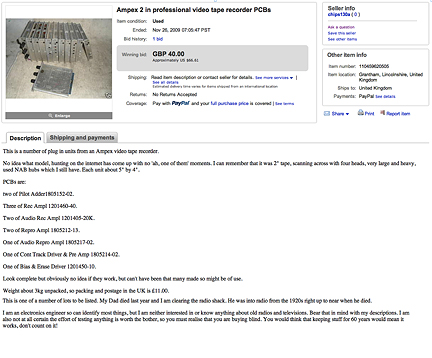Miles O’Brien and “This Week in Space” are back for their first show of 2010. In this episode: the space nation awaits direction from President Obama, Endeavour gets ready to deliver a room with a view, how an abandoned McDonald’s is being used to restore closeups of the Moon, a space telescope finds new planets, plus an interview with Hubble-Hugger-In-Chief John Grunsfeld. You also can subscribe for free to watch episodes from iTunes.
Data User’s Note: Lunar Orbiter Photographic Data
 NSSDC 69-05, Beeler and Michlovitz, June 1969
NSSDC 69-05, Beeler and Michlovitz, June 1969
Download document (2.7 MB PDF)
The primary purpose of this Data User’s Note is to announce the availability of Lunar Orbiter 1-5 pictorial data and to aid the investigator in the selection of Lunar Orbiter photographs for study. In addition, this Note can give some guidance to the interpretation of the pictures. As background information, the Note includes a breif description of the mission objectives and the photographic subsystem. The National Space Science Data Center (NSSDC) can provide all forms of photographs described in the section on Format of Available Data. It is recommended however, that the user frst order the 35-mm film to facilitate selection of those frames for which high-quality reproductions are needed.
Stan Lebar has Passed Away
 Passing of Stan Lebar, NASA Goddard
Passing of Stan Lebar, NASA Goddard
“Stan Lebar, who led the Westinghouse Electric Corporation team that developed the lunar camera that brought the televised news images of Neil Armstrong stepping onto the moon to more than 500 million people on earth, died on Tuesday, Dec. 22, 2009.”
“During his long and distinguished career, other camera programs he managed for NASA included the Apollo Color TV Cameras, the Skylab series of TV cameras, and the TV cameras for the Apollo-Soyuz Test Program (ASTP).”
The Boulders of Copernicus
This image represents a portion of the central uplift within the crater Copernicus. The image, LOV-152-H1, was taken by Lunar Orbiter V on 16 August 1967 at an altitude of 103 km. The spacecraft was looking straight down at the crater as it snapped this picture series. The resolution of this image is 2.2 meters/pixel. [Click on image to enlarge]
Below, you can see the increase in contrast and resolution that LOIRP has attained when you compare the high resolution USGS image (left) and the one obtained by LOIRP on 10 December 2009 (right). [Click on image to enlarge]
Live Webcast From McMoon’s

 Keith’s note: On Thursday, 10 December 2009, we conducted a live webcast from the Lunar Orbiter Image Recovery Project (LOIRP) at “McMoon’s” i.e. Building 596 at the NASA Ames Research Park.
Keith’s note: On Thursday, 10 December 2009, we conducted a live webcast from the Lunar Orbiter Image Recovery Project (LOIRP) at “McMoon’s” i.e. Building 596 at the NASA Ames Research Park.
Dennis Wingo and I give you a tour of our project including a walk through of the abandoned McDonald’s that has been our base of operations since 2008. We show you how we rack tapes, play them back, capture the data on a computer, and then stitch the image framelets together. You can look over our shoulders and see the imagery as it appears on one of our old TV monitors. We’ve picked an especially interesting tape to show you. Eventually this image will be posted online at LPI and submitted to the NSSDC.
This project has been funded and supported by a bunch of imaginative folks at ESMD, IPP, NLSI, ARC, SkyCorp, SpaceRef Interactive, and Odyssey Moon with assistance from a range of people ranging from retired Lunar Orbiter project personnel and Lockheed Martin employees to local high school and college students. Soon, we expect to have two tape drives fully operational and to be able to produce images on a daily basis.
Oh yes, in case you are wondering, I donate my time (and money) to this project. What fun. Its like bringing a time machine back to life in a high tech junkyard. We are looking to begin some pervasive EPO in coordination with NLSI and the Challenger Center for Space Science Education in the very near future.
Boulder Trails On The Moon
[Click on image to enlarge] Keith’s note: This image was taken on 21 November 1966 by Lunar Orbiter II at an altitude of 44 miles. The image is taken from frame 92, Framelet 445, and has resolution is 0.98 meters/pixel. As such the large boulder that has left a trail is around 6-7 meters in diameter. The image on the left shows the highest resolution image available online at LPI. On the right is the raw unproceesed image we retrieved this afternoon. While the large boulder’s trail is seen in both images, the details of that trail and the rest of the boulder field are much sharper in our newly retrieved image.
By coincidence this large boulder is very similar in size to “House Rock” a large boulder north of the Haughton Mars Research Station on Devon Island. That’s me standing on top if it.

This rock is a favorite place to pose for photos and was named after the large rock that Astronaut Jack Schmitt posed next to during the Apollo 17 mission.

Comparing USGS, LPI, and LOIRP Image Resolution (Update)
[Click to enlarge] Keith’s note: These images are taken from Lunar Orbiter II image LOII_092H1 Framelet 522. On the left is the highest resolution scanned version available online at LPI (or USGS). On the right is our partially processed version that we retrieved this morning. In addition to providing a much sharper image, note that our new image also allows contrast to be controlled such that features can seen in the areas that are darkened in the older image.
Right now we are focusing on retrieving Lunar Orbiter II images at the request of both LPI and USGS since high resolution (modern) scans have yet to be done for this mission’s images. We hope to have the entire image online later today complete with collapsed lava tubes (?) and giant boulders sitting in the middle of otherwise flat plains. With our recently enhanced (restored) original FR-900 tape drive and its recently restored sister drive we will soon have two fully functional drives in operation and will be able to (eventually) retrieve and release images on a daily basis.
I will be doing a live webcast tomorrow at 1pm PST wherein we give you a tour of our facility and watch as we pull a new image back from history and into the present. Details to follow.
Seeing Boulders on The Moon
[Click on image to enlarge] Keith’s note: Tonight we are testing out our newest Mac computer at the Lunar Orbiter Image Recovery Project located at NASA ARC. We’ll be using this machine (8 processors and 10 TB of storage) to do near-real time processing of imagery once we have pulled it off of original Lunar Orbiter analog data tapes using our restored FR-900 tape drives. We hope to do a live webcast this coming Thursday so that you can look over our shoulders as we bring another image to light for the first time in more than 40 years.
Tonight, as we were flying through a portion of one of the images we came across a boulder field. Here is the image archive at LPI – subframe H3, Framelet 323. The image was taken by Lunar Orbiter II on 20 Nov 1966 at an altitude of 52.2 miles with a ground resolution of 1.14 meters/pixel. The framelet image shown here is approximately 220 meters across. You can clearly make out a number of boulders around 1 meter in size sitting on the surface.
New Hardware

Keith Cowing at McMoon’s (Bldg 596) at the NASA Ames Research Park preparing to install five 2 TB drives in a new Mac that will be used for post-downloading image processing.
More Lost Apollo Data Tapes Discovered
 WA physicist’s ‘Moon Dust’ tapes may hold keys to future lunar landings
WA physicist’s ‘Moon Dust’ tapes may hold keys to future lunar landings
“A set of original NASA data tapes from moon landings in the 1960s now held in Western Australia may hold the keys to overcoming problems associated with the effects of lunar dust on future moon missions. They are also set to help kickstart the Australian Government’s recently launched space research program. The 177 original (or primary) data tapes – most likely the only tapes of their kind in the world – contain the results of experiments using dust detectors on the surface of the moon by Apollo 11, 12 and 14 astronauts. They have been recently supplemented by secondary data from Apollo 12, 14 and 15 missions.”
Buying Lunar Orbiter Tape Drive Parts on eBay
 Dennis Wingo: Last night on the Ampex mailing list the following message was posted:
Dennis Wingo: Last night on the Ampex mailing list the following message was posted:
Over on the oldvtrs list, someone pointed out this eBay item: 110459620505
Several of us immediately identified them, not as quad modules, but as VPR-7900 modules. Then another member pointed out that they were the wrong size which caused me to take a closer look. I have just checked the actual machines to be certain, and also checked the manuals and the Ampex part number guide. Now, this has turned into a major mystery. Here’s what I can tell you with absolute certainty:
1) The style of the front panels is like the 7900 series (ground jacks and board function listed at the bottom of each module…they are upside down in the pic), but the module functions, layout and part numbers do not match the 7900 (or 7800) series. They are also the wrong size.
2) The part numbers listed are all in the range of the part numbers used for the quad machines! The part numbers for the 7900 series was entirely different.
The seller seems quite sure that these were from a 2″ quad. The part numbers seem to indicate that could be the case. Anyone have any ideas????? Perhaps something from special products division???? This is extremely curious!!!
Don
I thought this was interesting and since I am always looking for spares for our LOIRP FR-900’s I checked it out on eBay. Here is the page I found.
Larger view
When I looked I was pretty certain that these were boards from our FR-900 machines. It had the right part numbers, so I called Ken Zin at home the night before Thanksgiving and asked him to verify, which he did and noted that these are newer version boards of the ones that we have!! So I bid on them and won them today.
I got this message from Don Norwood later:
Dennis:
Oh my, from the limited info I have, I can see that now! And in fact, they’re not upside down in the pic as that orientation is correct for the FR-900. Wow! I hope you can use them!
So, after winning the boards on Ebay, we are pursuing the boards to get them shipped to us and to see if this fellow has some more. We will try to get the story from him of his dad and how he might have come by these extremely rare boards. In the year and a half of our project, this is the FIRST time that we have found anything related to the FR-900 hardware that did not come from Nancy Evans.
A Day in the Life of LOIRP

Louisa Smith visiting the lab today.

Engineer Ken Kledzik designing and building a new VCO for the FR-900

Ken still working today on the VCO design and build

Our pirate flag, with the sun behind it.

Lunar Orbiter II_092 image tape being run.






